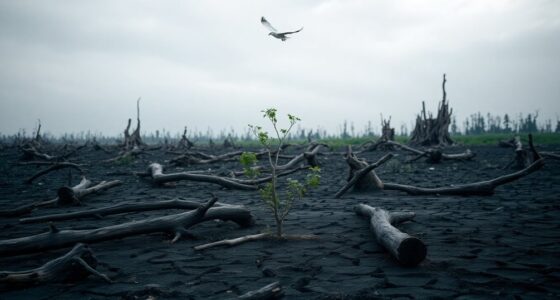Evolution in action happens when populations become isolated by geographic barriers or develop reproductive differences, leading to new species. Environmental factors and natural selection drive adaptations that distinguish one group from another. Sometimes, changes like chromosome doubling quickly create new reproductive groups, especially in plants. Over time, diverse species arise from a common ancestor through processes like allopatric and sympatric speciation, or adaptive radiation. Keep exploring to understand how these fascinating processes shape life’s incredible diversity.
Key Takeaways
- Geographic barriers like mountains and rivers prevent gene flow, leading to isolated populations that can diverge into new species.
- Reproductive barriers such as different mating times or behaviors develop as populations diverge, reinforcing speciation.
- Polyploidy, especially in plants, causes instant reproductive isolation through chromosome doubling, rapidly producing new species.
- Adaptive radiation occurs when species diversify quickly to exploit different ecological niches, often on islands.
- Environmental factors and natural selection favor traits suited to specific conditions, driving genetic divergence and new species formation.
The Role of Geographic Barriers in Species Formation
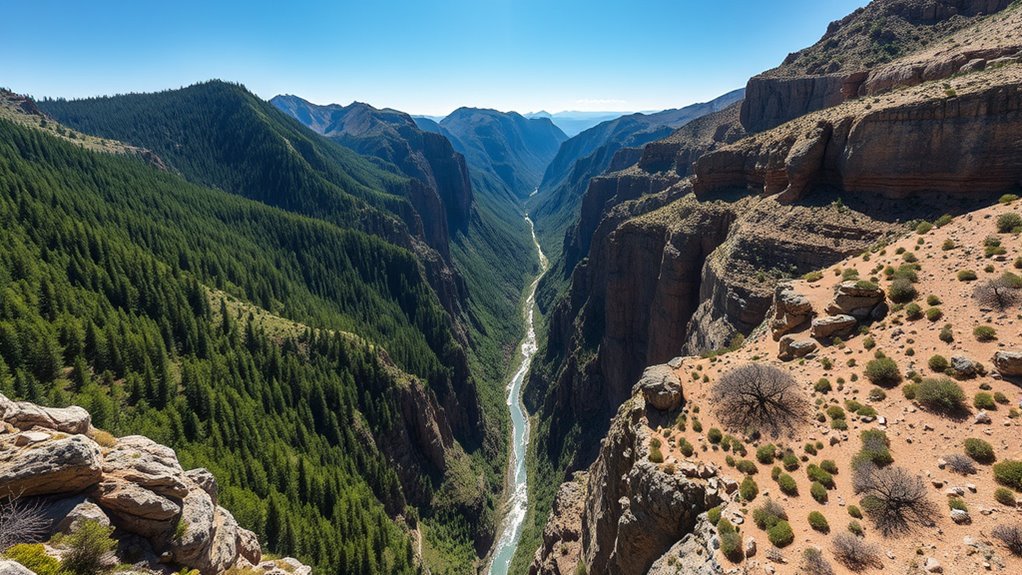
Geographic barriers play a crucial role in species formation by physically separating populations and preventing gene flow. When a barrier like a mountain range, river, or rockslide blocks a population’s movement, groups become isolated from each other. Over time, each population faces different environmental conditions and selective pressures. You’ll see natural selection favor different traits in each group, leading to genetic divergence. Because they can’t interbreed, reproductive barriers develop, and these isolated populations gradually become distinct species. For example, squirrels on opposite sides of the Grand Canyon have diverged into separate species due to this process. By blocking gene exchange, geographic barriers set the stage for populations to evolve independently, increasing the diversity of life on Earth. Additionally, high contrast ratios in visual displays can influence mate selection, further driving speciation in certain species. Such variations in traits are often reinforced by selective pressures, promoting divergence among isolated groups.
How Reproductive Isolation Drives Divergence

Reproductive isolation is a key mechanism that drives divergence between populations by preventing gene flow. When populations become reproductively isolated, they no longer exchange genes, allowing each group to evolve independently. Different environmental pressures or behaviors can lead to changes in mating rituals, timing, or preferences, making interbreeding impossible. For example, if two populations develop distinct mating calls or breed at different times, they can’t produce viable offspring together. Over generations, these reproductive barriers cause genetic differences to accumulate, reinforcing divergence. As traits adapt to local conditions or behaviors shift, reproductive isolation solidifies, ultimately resulting in separate species. This process ensures that genetic differences are maintained and amplified, driving the ongoing evolution of biodiversity. Additionally, understanding the breed-specific traits can help explain how certain populations develop unique characteristics that contribute to reproductive barriers.
The Impact of Natural Selection on Genetic Differences
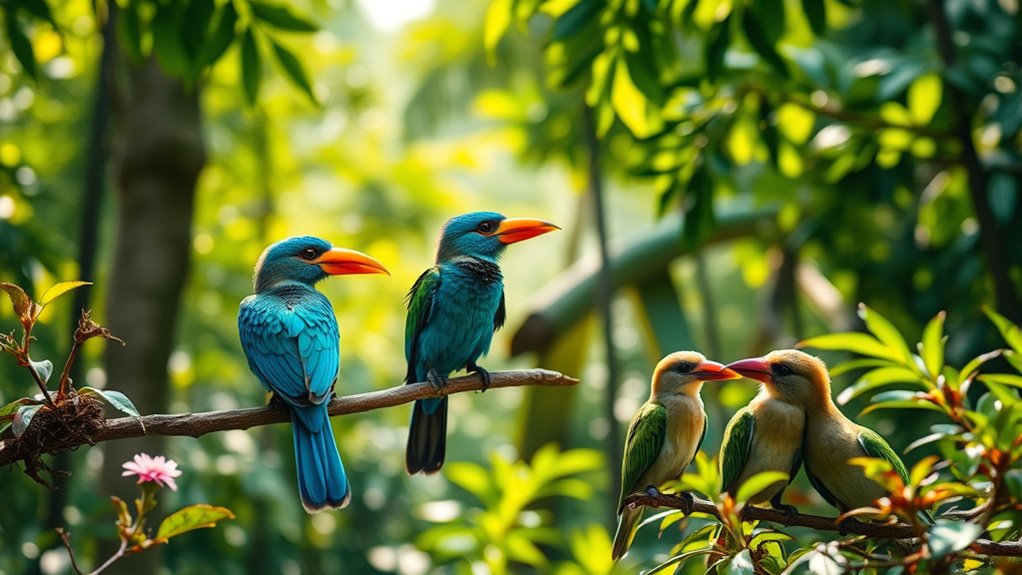
You can see how natural selection drives genetic differences by favoring traits that help populations survive in their specific environments. As conditions change, traits that provide advantages become more common, leading to divergent adaptations. This process shapes the diversity of life you observe across different habitats and species. Additionally, understanding crypto pump patterns can shed light on how market behaviors reflect collective responses to external stimuli, similar to evolutionary pressures. Recognizing genetic variation is crucial because it provides the raw material for natural selection to act upon, ultimately influencing evolutionary outcomes. The presence of selective pressures in various environments further accelerates these genetic shifts, reinforcing the dynamic nature of evolution. Moreover, environmental factors such as climate and resource availability directly influence which traits become advantageous, further shaping evolutionary pathways. Conducting population studies helps scientists observe these genetic changes over time to better understand evolutionary processes.
Divergent Trait Development
Natural selection drives divergent trait development by favoring different characteristics in populations exposed to varying environmental conditions. As environments change, certain traits become more advantageous, leading individuals with those traits to survive and reproduce more successfully. Over generations, these traits become more common within each population. Because different populations encounter distinct challenges—such as climate, food sources, or predators—they develop unique adaptations. This process increases genetic differences between groups, pushing them further apart. These genetic variations influence physical features, behaviors, and reproductive strategies. As divergence continues, populations may become increasingly incompatible, eventually leading to reproductive isolation. Divergent trait development is a key force behind the formation of new species, illustrating how natural selection shapes diversity over time. Additionally, artistic practices have evolved as societies adapt to new materials and cultural meanings, reflecting broader environmental and societal changes. Understanding these processes can also shed light on how speciation occurs through gradual genetic divergence driven by environmental pressures. This ongoing divergence highlights the importance of genetic variation in evolutionary processes. Moreover, environmental pressures act as catalysts that accelerate the divergence process, leading to more rapid speciation events when conditions strongly favor certain traits. Furthermore, the role of mutation introduces new genetic material that can contribute to divergence and adaptation.
Environment-Driven Adaptations
Environmental factors play a vital role in shaping the genetic makeup of populations through natural selection. You see, as conditions change, certain traits become more advantageous. Over generations, these traits increase in frequency, leading to genetic differences within populations. For example, animals adapting to different habitats develop distinct features suited to their environment. This process drives evolution and can eventually cause new species to form. To understand better, consider this table:
| Environmental Factor | Resulting Adaptation |
|---|---|
| Cold climate | Thicker fur or fat layers |
| Bright sunlight | Enhanced vision or pigmentation |
| Limited food | Efficient foraging traits |
| Predation pressure | Camouflage or speed |
| Water scarcity | Drought-resistant traits |
These adaptations showcase how natural selection shapes genetic diversity based on environmental pressures.
Allopatric Speciation: When Geography Divides Species

When a geographic barrier like a mountain or river separates populations, it creates isolation that prevents gene flow. Over time, different environmental pressures in each area cause the groups to adapt uniquely, driving genetic divergence. Additionally, the presence of local laws and resources can influence the survival and adaptation of populations, further promoting divergence. The selective pressures exerted by these differing environments can lead to the development of reproductive barriers that prevent interbreeding between groups. Furthermore, speciation mechanisms play a crucial role in solidifying reproductive isolation, ensuring the persistence of the new species. Eventually, reproductive barriers form, making interbreeding impossible and leading to the emergence of new species.
Geographic Barriers Create Isolation
Geographic barriers play a essential role in allopatric speciation by physically separating populations and preventing gene flow. When mountains rise, rivers carve new paths, or landslides block movement, populations become isolated. Without contact, each group adapts to its unique environment over generations. Natural selection favors different traits, gradually causing genetic divergence. As these differences accumulate, reproductive barriers develop, making interbreeding impossible. For example, squirrels on either side of the Grand Canyon have evolved into distinct species due to this separation. You’ll find that such barriers create the perfect conditions for new species to emerge, as populations evolve independently, driven by their local environments and the lack of genetic exchange with others. This process highlights how physical geography directly influences the course of evolution.
Divergent Environmental Pressures
Have you ever wondered how similar populations can evolve into distinct species when they face different pressures? When populations become geographically separated, they encounter unique environments. These divergent conditions apply different selective pressures, favoring different traits in each group. For example, one population might adapt to colder temperatures, developing thicker fur, while the other adjusts to a warmer climate by shedding excess insulation. Over many generations, these adaptations cause genetic differences to accumulate. Natural selection reinforces traits suited to each environment, gradually driving the populations apart. As these differences grow, reproductive isolation occurs, making interbreeding impossible or less successful. This process, known as allopatric speciation, illustrates how environmental divergence alone can lead to the emergence of new species. Additionally, germination period plays a crucial role in how quickly populations can adapt to their environments, influencing the pace of speciation. The rate at which genetic changes accumulate can also be affected by the mutation rate, further impacting the speed of divergence.
Reproductive Barriers Develop
As populations become separated by physical barriers, reproductive barriers gradually develop, preventing them from interbreeding successfully. This process, known as allopatric speciation, leads to genetic divergence. Over generations, different environments favor distinct traits, making hybrids less viable or sterile. The table below illustrates how reproductive barriers evolve:
| Barrier Type | Example |
|---|---|
| Temporal | Different mating seasons |
| Behavioral | Changes in mating songs |
| Mechanical | Incompatible reproductive organs |
| Gametic | Sperm and egg incompatibility |
| Ecological | Preference for different habitats |
These barriers solidify reproductive isolation, ensuring each population evolves into a separate species. As gene flow ceases, traits diverge further, cementing the speciation process.
Exploring Sympatric Speciation and Its Mechanisms
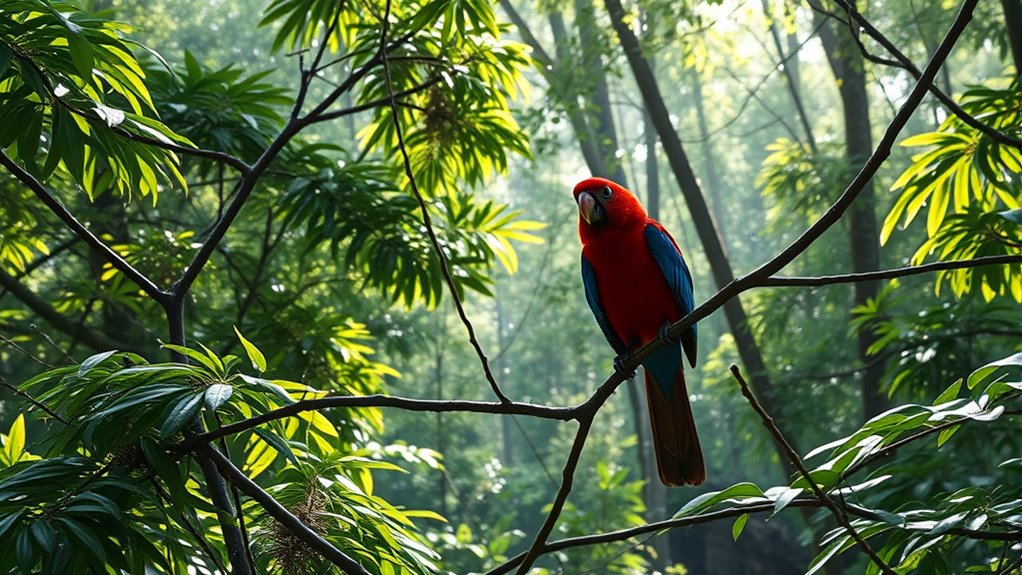
Sympatric speciation occurs when new species arise within the same geographic area without physical barriers separating populations. You might think that physical separation is necessary for speciation, but in sympatric cases, other factors drive divergence. One key mechanism is behavioral differences, such as shifts in mating preferences or timing, which reduce interbreeding. Genetic changes like polyploidy, especially common in plants, can instantly produce reproductive isolation by doubling chromosome numbers. Hybridization between related species can also generate new, reproductively isolated groups. These hybrids may reproduce vegetatively or develop unique traits that prevent interbreeding with parent populations. As a result, even without physical barriers, populations can diverge genetically over time, leading to the emergence of new species within the same area. Additionally, environmental factors and resource-based specialization can promote divergent selection, further facilitating speciation processes. This process underscores the importance of reproductive isolation mechanisms in maintaining distinct species identities. Moreover, understanding the role of genetic divergence helps clarify how genetic differences accumulate over generations, reinforcing species boundaries and contributing to speciation in diverse ecosystems. Research shows that behavioral isolation can be a significant driver of divergence in sympatric populations.
Polyploidy: A Plant-Centric Pathway to New Species

Polyploidy stands out as a particularly effective mechanism for plant speciation, often occurring suddenly and producing immediate reproductive isolation. When a plant’s chromosome number doubles, it creates a genetic barrier that prevents it from breeding with its original population. This process can happen spontaneously through errors during cell division, resulting in polyploid individuals. These new plants often exhibit distinct traits, such as increased size or varied resilience, giving them an advantage in certain environments. Because they can reproduce vegetatively or through self-fertilization, polyploid plants establish stable, separate populations quickly. Many crop species, like wheat, cotton, and potatoes, originated through this pathway. Polyploidy therefore provides a rapid, plant-centric route to the emergence of new, reproductively isolated species. Understanding polyploidy can help researchers develop improved crop varieties and conservation strategies.
Adaptive Radiation: Diversification From a Single Ancestor

Have you ever wondered how a single species can give rise to many different ones in a relatively short period? Adaptive radiation happens when one ancestral species disperses into new environments, each with unique conditions. You see this often on islands, where geographic isolation helps populations adapt to specific niches. For example, Hawaiian honeycreepers evolved from a common ancestor into dozens of species, each with specialized beak shapes for different food sources. Similarly, Darwin’s finches in the Galápagos diversified to exploit various seed types. This process involves natural selection driving populations to adapt rapidly to their local habitats, leading to reproductive isolation. Over time, these adaptations solidify into distinct species, illustrating how a single ancestor can diversify into a broad array of new species.
The Significance of Peripheral Populations in Evolution
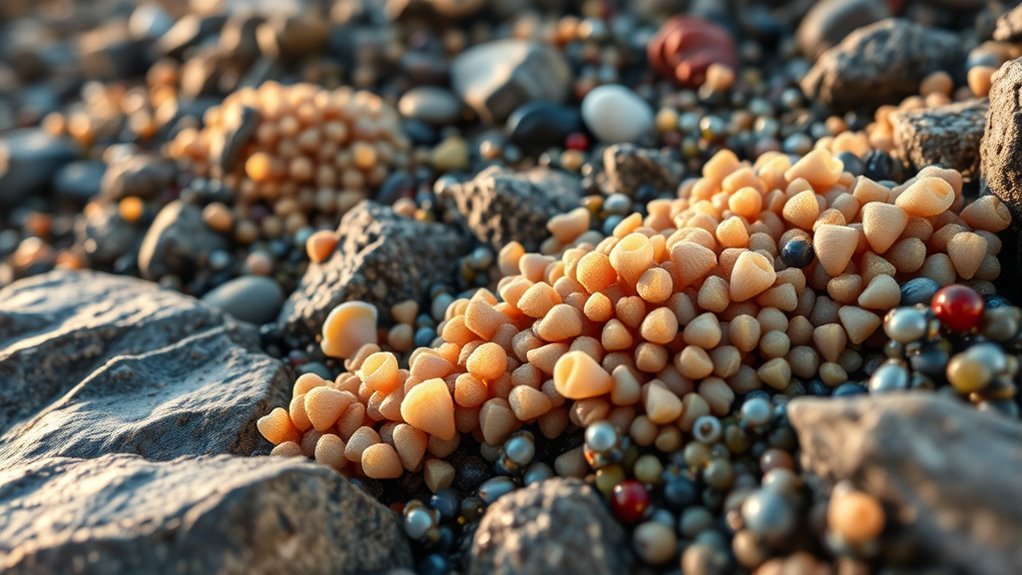
While adaptive radiation highlights how species diversify from a common ancestor across various habitats, the role of peripheral populations adds an important layer to understanding evolution. These small, isolated groups at the edges of a species’ range experience distinct environmental pressures, leading to rapid genetic changes. Because gene flow between peripheral and main populations is limited, peripheral groups can diverge quickly, developing unique traits. This divergence can eventually result in reproductive isolation, a key step toward new species formation. For example, mosquitoes in underground habitats have evolved different behaviors and adaptations from their surface counterparts. Peripheral populations act as evolutionary experiments, increasing diversity and providing the raw material for speciation. Their study reveals how localized ecological factors influence the broader process of species emergence.
Case Studies: Real-World Examples of Speciation Processes

Real-world examples vividly illustrate how different mechanisms drive speciation. You can see allopatric speciation in Grand Canyon squirrels, which diverged into distinct species after geographic barriers separated their populations. Sympatric speciation occurs in plants like wheat and cotton, where polyploidy creates new reproductive species within the same area. Adaptive radiation is exemplified by Hawaiian honeycreepers, which evolved diverse beak types to exploit different food sources on islands. To deepen your understanding, consider these points:
Examples like Grand Canyon squirrels, wheat, and Hawaiian honeycreepers show how different mechanisms drive speciation.
- Geographical barriers can lead to reproductive isolation, as with mountain ranges or rivers.
- Chromosome doubling in plants creates new species rapidly through polyploidy.
- Island environments foster adaptive radiation, producing numerous specialized species from a common ancestor.
Frequently Asked Questions
How Do Genetic Mutations Contribute to Speciation?
Genetic mutations drive speciation by introducing new traits into populations. When mutations occur, they can alter genes responsible for key characteristics, leading to variation. If these changes provide advantages or become fixed in isolated populations, they promote genetic divergence. Over time, such mutations contribute to reproductive isolation, making it impossible for different populations to interbreed successfully, ultimately resulting in the emergence of new species.
Can Reproductive Barriers Be Overcome Over Time?
Reproductive barriers can sometimes be overcome, but it’s an epic struggle like trying to reunite a shattered universe. Over many generations, genetic changes, mutations, and environmental shifts might slowly erase differences, allowing interbreeding again. However, often these barriers become so entrenched that crossing them becomes nearly impossible, sealing the fate of separate species forever. Still, evolution’s power keeps the door slightly ajar for occasional hybridization and future reunions.
What Roles Do Environmental Changes Play in Speciation?
Environmental changes play a pivotal role in speciation by creating new pressures that drive populations to adapt. You might see populations evolve different traits to survive altered conditions, leading to reproductive isolation over time. These changes can also create new habitats or barriers, prompting allopatric or sympatric speciation. As environments shift, they push species to diversify, ultimately resulting in new, distinct species better suited to their evolving surroundings.
Are All New Plant Species Formed Through Polyploidy?
No, not all new plant species are formed through polyploidy. Imagine a garden where some plants bloom into new varieties by doubling their chromosomes like a mirror reflecting a new image, while others evolve through different paths like adaptation or hybridization. Polyploidy is a major but not the sole route; plants can also diversify via natural selection, hybrid formation, and other genetic mechanisms shaping the lush tapestry of plant evolution.
How Does Gene Flow Affect the Process of Speciation?
Gene flow can slow down or even prevent speciation by mixing genetic material between populations, keeping them similar. When gene flow is strong, it maintains genetic diversity within a population, making it harder for reproductive barriers to form. However, if gene flow decreases due to geographic or behavioral barriers, populations can diverge more easily, leading to speciation. So, reduced gene flow promotes the development of new species.
Conclusion
You’re like a traveler witnessing the grand dance of evolution, where each step—whether a mountain, a river, or a tiny genetic twist—guides species into new forms. These natural barriers and reproductive quirks craft a mosaic of life’s diversity. Just as a river carves valleys or a seed finds its root, evolution shapes life’s endless tapestry. Keep watching—nature’s masterpiece never ceases to surprise and inspire you.


